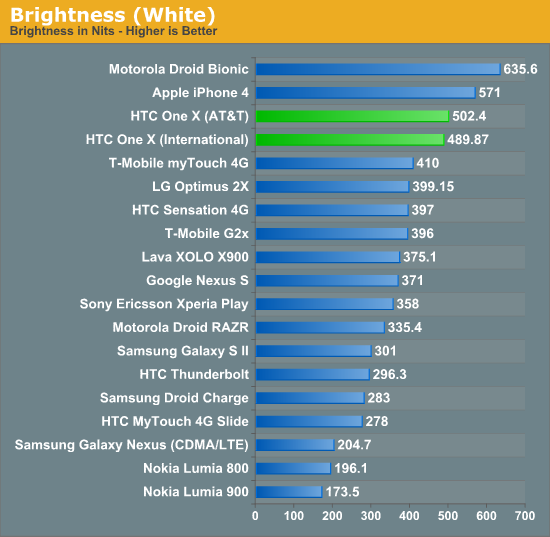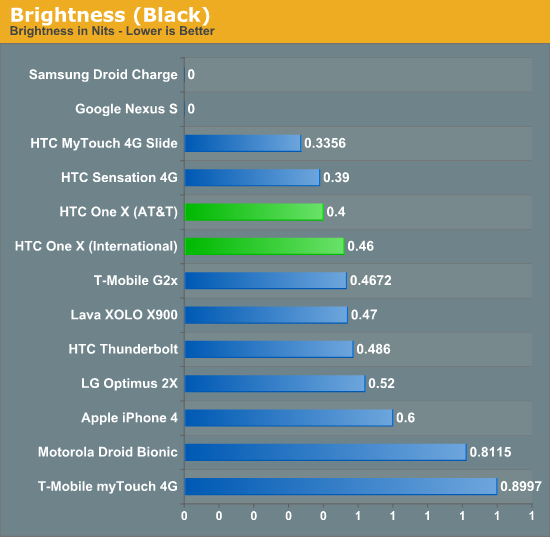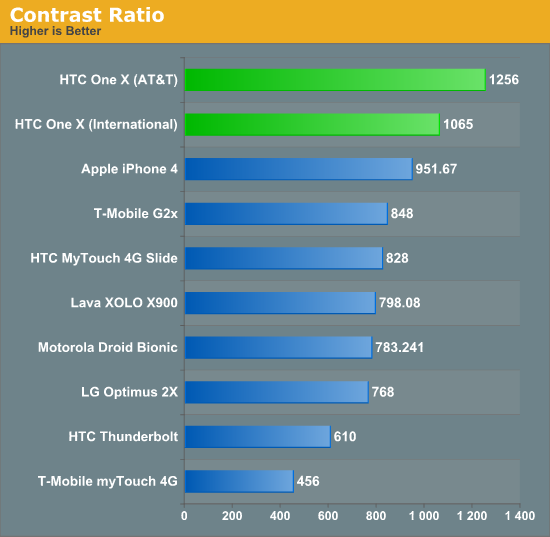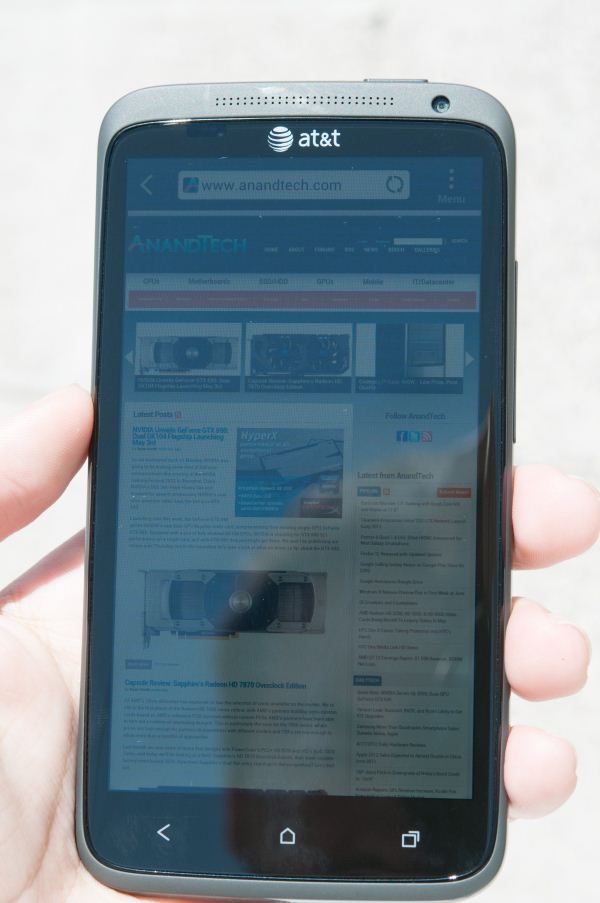The HTC One X for AT&T Review
by Brian Klug on May 1, 2012 6:00 PM EST- Posted in
- Smartphones
- Snapdragon
- HTC
- Qualcomm
- MSM8960
- Krait
- Mobile
- Tegra 3
- HTC One
- NVIDIA
The One X has a 4.7“ 1280x720 display that’s beautiful, dubbed the ”infinity screen.“ In fact, that’s really all you need to know about it - it’s absolutely wonderful, and honestly if you’re concerned with mobile displays just stop right there. At above 4.5” diagonal, 720p seems to be the new norm, and the combination of that 4.7" diagonal size and 720p on the HTC One X results in a PPI of 312. HTC shipped a device with an LCD display last year whose pixel density exceeded the iPhone 4/4S Retina Display for the first time in the HTC Rezound, which was 341 PPI.
Nevertheless the HTC One X still has subpixels small enough that I can’t visually distinguish them at all but from the most extreme distances. In addition, because it’s LCD you get an RGB stripe as opposed to PenTile RGBG like what currently ships on Samsung’s SAMOLED HD displays at 720p in the Galaxy Nexus.
I did some poking around, and my HTC One X (AT&T) review unit has a Sony display:
[DISP] mipi_video_sony_hd720p_init: assign initial setting for SONY_NT id 0x18103 Cut1, PANEL type = PANEL_ID_ELITE_SONY_NT



The panel goes extremely bright, at over 500 nits maximum, and has top of the chart contrast. As always I characterized the One X display using a combination of ColorHCFR and an i1D2 and Francois’ excellent Voodoo Screen Test Pattern generator application.
I’ve made both the color.chc file and measures available. The CIE diagram shows that HTC’s Infinity Display has very close to sRGB coverage, however color temperature is on the red side at just under 6000K. That’s really my only gripe, and curiously enough the One S with SAMOLED qHD displays are closer to 6500K than the LCD packing HTC One Xes.
Viewing angles look good on the HTC One X, there's no visible color shift at extreme angles. Outdoor viewing is also pretty good on the HTC One X, thanks in part to optical bonding between the display glass and LCD itself. One fewer air gap means fewer Fresnel reflections which quickly turn a display into a mess outdoors.
























137 Comments
View All Comments
metafor - Wednesday, May 2, 2012 - link
His point is that blacks on an LCD require far more power than on an AMOLED. Since a black pixel on an AMOLED = no power used.I'm curious as to how the power consumption of a fully white AMOLED screen of equal pixel density and screen size compares to that of an LCD -- at equal brightness of course. This actually shouldn't be very difficult to test and really would be nice in one of these reviews.
Take the Galaxy Nexus or the upcoming GS3 and the One X, turn off everything (airplane mode, kill all background processes) and disable auto-lock/auto-dim. Turn the screen to various levels of brightness while displaying a pure white screen (several apps will do this).
Then see how long the phone takes to go from 100% battery to 0%. Extrapolate based on how large the battery is in WH rating.
Then compare the two.
Lucian Armasu - Saturday, May 12, 2012 - link
Which is why I find it very weird that Samsung didn't go with a more stock ICS dark look for their Galaxy S3. ICS feels like it was made for AMOLED displays, and yet Samsung refuses to use it. Shame.ilkhan - Tuesday, May 1, 2012 - link
I stopped reading at this line:"however the device does not work with T-Mobile WCDMA and the One XL page lists the correct air interface support."
The rest of it was totally irrelevant after that.
Pity. That screen has been getting tons of praise.
Maybe the OneX2 will include a proper GPU and TMo support.
ilkhan - Tuesday, May 1, 2012 - link
(no edits?)It was already borderline without a replaceable battery and without an mSD slot. The frequency support just closes the book for sure.
Which really is a pity. The android phones first got started by word of mouth "expandable storage, easy to hack, total control, function over form", the antithesis of apple. Now they are racing to embrace all the bullshit that apple did 5 years ago. We don't need 7mm thick phones. Gimme the extra 2 extra mm of thickness if it means I get an mSD slot and replaceable larger battery, I'll be happier that way.
metafor - Tuesday, May 1, 2012 - link
Having come from a Sensation to a One S, I gotta say, I love the 7mm thin factor over almost everything else (the weight too). With dropbox and Google music, most of my needs for large storage has been eliminated.ImSpartacus - Tuesday, May 1, 2012 - link
Just wait. When the market goes far enough in one direction, it opens up a niche market in the other direction.You might end up having to use a developer device or something like that, but you'll get your wish.
Zoomer - Wednesday, May 2, 2012 - link
I would like my 4 hardware buttons too. microSIM I suppose is acceptable, though the use of a special tool for access is not.So:
AMOLED
microSD
Physical Buttons
Trackball
Swappable batteries would be a plus, if only for easier debugging / full off.
Zoomer - Wednesday, May 2, 2012 - link
Oh almost forgot, HTC branding on the top of the glass. HTC's the manufacturer, NOT AT&T. AT&T is just pipe. ;)kmmatney - Wednesday, May 2, 2012 - link
You can always get an external USB battery to use an an extra battery (and it can charge other things to).sprockkets - Tuesday, May 1, 2012 - link
That's why they make the One S. Shame that has to be the case, but you might like the metal case better. I wish I could open it like the sensation though.